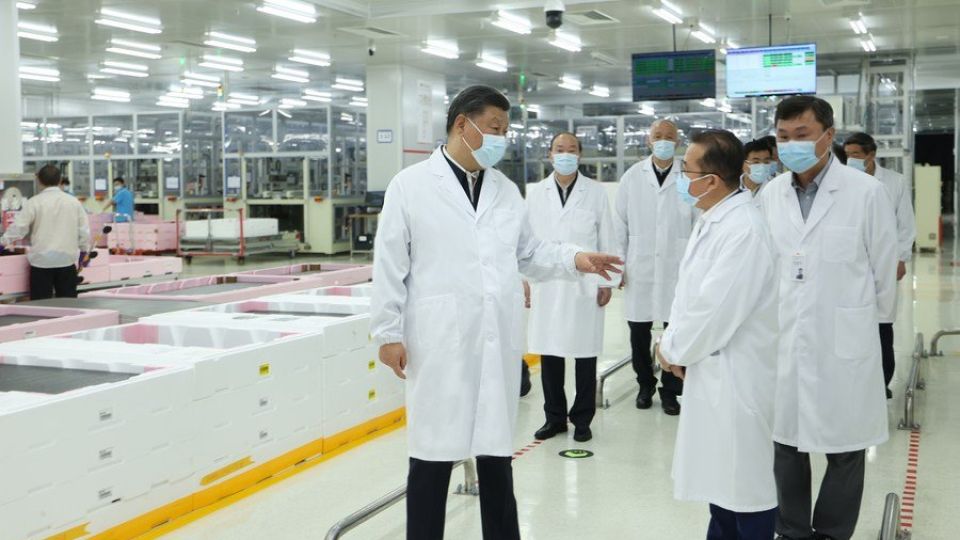April 17, 2023
SEOUL – The rare visit of Chinese President Xi Jinping to LG Display’s local manufacturing facility in China last week came as a surprise to South Korea’s display industry, raising both excitement and concerns over the intention behind the visit amid the intensifying Washington-Beijing tech rivalry.
In his visit to the LG plant in Guangzhou, Guangdong Province on Wednesday, Xi underscored how China can provide an excellent ground for foreign businesses to thrive, and expressed hopes for foreign investors to “seize opportunities and achieve greater business success” by coming to China.
Xi’s remarks that China is determined to “deepen reform” and to “high-standard opening-up” toward foreign firms were largely well-received in South Korea, having the country as its biggest trade partner.
At the same time, Korean display makers also worried that Xi’s visit — his first to a Korean worksite in China since he took office more than a decade ago — could mean the technology war between the two superpowers will spill over to them.
“Xi’s visit comes as the conflict between China and the US is escalating, and it looks like the country wants to attract more foreign investment to boost its economy,” an industry official told The Korea Herald under condition of anonymity.
“But it still raises some concerns that the Chinese president might be making preemptive moves after learning the US is moving to adopt some kind of a program like the CHIPS Act, that could come as a form of pressure to limit business operations in China,” the official added.
Among its efforts to contain Beijing’s technological clout, Washington has introduced a government funding program wooing global chipmakers to build manufacturing facilities on US soil rather than China.
Under the program, the US proposes to offer ample funding for companies under the condition that the recipients limit expanding their chip production in China for at least a decade.
While chips and batteries for electric vehicles have become industrial battlefields for US-China tensions in recent years, Korean display makers appeared to be distancing themselves from geopolitical risks.
Having already succumbed to Chinese rivals when it comes to cheaper LCDs, Korea’s top display makers – Samsung Display and LG Display – have poured resources into more sophisticated OLEDs to maintain their technological prowess.
But Xi’s highly-publicized visit to the Korean display plant spurred speculation that a similar war for hegemony could unfold if one of the two superpowers decides to “weaponize” the display industry to use against the other.
“There are so many companies in the (Guangdong) region, and China’s powerful leader included the Korean display maker’s facility in his itinerary. Doesn’t it mean something?” the official said.
The LG Display plant in Guangzhou is operated by LG Display Hightech China, a 70:30 joint venture between LG and the provincial government. The facility, located on a 700,000-square-meter site, currently produces 8.5-generation OLED panels for high-end TVs.
Some industry officials downplayed the implication of Xi’s visit, calling it just a part of his inspection tour following his meeting with French President Emmanuel Macron in the region in the previous week.
“Xi’s primary purpose in visiting Guangdong Province was to meet with the French president, and then he toured the region to inspect various industries there,” another industry official said under the condition of anonymity.
“For choosing the Korean display maker’s worksite, it could be just that China wants to improve ties with South Korea. Or it could be a warning for South Korea to not fall for the US, and maintain bilateral relations with China,” the official added.
Yi Choong-hoon, an industry veteran and CEO of market tracker UBI Research, also said Xi’s recent visit to LG Display’s local facility should not be a factor of concern, saying China has already gained an upper hand in the LCD market. The US has no reason to enter the already crowded display market for the sake of keeping China in check.
But he said that South Korea should gear up for some challenging competition as the Chinese government is apparently moving to boost the display industry by merging smaller companies, similar to the chip industry.
“China would still be fully capable of ‘weaponizing’ its competitive edge in display to bully the rivals, especially ones that have strong ties with the US,” Yi said.
In order for Korean display makers Samsung Electronics and LG Electronics — who are the dominant players in the OLED market — to enhance their competitiveness, they must maintain their leadership in the consumer market for OLED-using appliances from smartphones to OLED TVs, he stressed.
“It would only take years for Korean display makers to give way to China if they cannot secure consumer demand, just like what happened with JOLED, the Japanese display maker that recently filed for bankruptcy,” Yi added.


